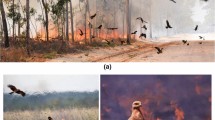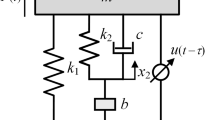Abstract
The three-element tuned mass damper (T-TMD) is an effective passive control device for single-degree of freedom structures due to harmonic external force. Unlike previous studies, this study aims at proposing a methodology for optimization of T-TMD positioned at the top floor of multi-degree of freedom structures under seismic loads. The equations of motion for a multi-story building controlled by a T-TMD are derived, and the T-TMD is then optimized using an advanced firefly algorithm (AFA) in the frequency domain. The aim of the optimization is to minimize the amplitude of the acceleration transfer function of the top floor of the building. The proposed methodology is implemented in two different shear buildings, and the optimum parameters are then verified by using benchmark earthquakes with different frequency components. The comparisons with the available works illustrate the availability of the AFA. The effect of the mass ratio on the optimum parameters of the T-TMD is also discussed in detail. Numerical results show that the use of the optimum T-TMD is an effective strategy to minimize the maximum structural responses of the multi-story buildings under seismic excitations. In particular, the optimum T-TMD is very effective when the maximum story responses (i.e., displacement and acceleration) occur at the top floor of the building.


















Similar content being viewed by others
References
Frahm H (1911) Device for damping of bodies. US Patent 989, 958
Ormondroyd J, Den Hartog JP (1928) The theory of dynamic vibration absorber. Trans Am Soc Mech Eng 50:9–22
Den Hartog JP (1956) Mechanical vibrations. McGraw-Hill, New York
Tsai HC, Lin GC (1993) Optimum tuned-mass dampers for minimizing steady-state response of support-excited and damped systems. Earthq Eng Struct Dyn 22(11):957–973
Hadi MN, Arfiadi Y (1998) Optimum design of absorber for MDOF structures. J Struct Eng 124:1272–1280
Lee CL, Chen YT, Chung LL, Wang YP (2006) Optimal design theories and applications of tuned mass dampers. Eng Struct 28(1):43–53
Lavan O, Daniel Y (2013) Full resources utilization seismic design of irregular structures using multiple tuned mass dampers. Struct Multidisc Optim 48(3):517–532
Venanzi I (2015) Robust optimal design of tuned mass dampers for tall buildings with uncertain parameters. Struct Multidisc Optim 51(1):239–250
Salvi J, Rizzi E (2016) Closed-form optimum tuning formulas for passive tuned mass dampers under benchmark excitations. Smart Struct Syst 17(2):231–256
Miranda JC (2016) Discussion of system intrinsic parameters of tuned mass dampers used for seismic response reduction. Struct Control Health 23(2):349–368
Araz O, Kahya V (2018) Effects of manufacturing type on control performance of multiple tuned mass dampers under harmonic excitation. J Struct Eng Appl Mech 1(3):117–127
Djerouni S, Ounis A, Elias S, Abdeddaim M, Rupakhety R (2022) Optimization and performance assessment of tuned mass damper inerter systems for control of buildings subjected to pulse-like ground motions. Structures 38:139156
Lee BH, Chen CC, Chen TW, Shiao SY, Jiang CR, Yeh FY (2022) Enhancement of structural seismic performance of low-rise buildings using displacement-dependent tuned mass damper. Structures 37:11191128
Araz O (2020) Effect of detuning conditions on the performance of non-traditional tuned mass dampers under external excitation. Arch Appl Mech 90:523–532
Sadek F, Mohraz B, Taylor AW, Chung RM (1997) A method of estimating the parameters of tuned mass dampers for seismic applications. Earth Eng Struct Dyn 26:617–635
Liu MY, Chiang WL, Hwang JH, Chu CR (2008) Wind-induced vibration of high-rise building with tuned mass damper including soil-structure interaction. J Wind Eng Ind Aerodyn 96:1092–1102
Lu X, Chen J (2011) Mitigation of wind-induced response of Shanghai center tower by tuned mass damper. Struct Des Tall Spec Build 20:435–452
Alkmim MH, Fabro AT, Morais MVG (2018) Optimization of a tuned liquid column damper subject to an arbitrary stochastic wind. J Braz Soc Mech Sci Eng 40:551
Ghassempour M, Failla G, Arena F (2019) Vibration mitigation in offshore wind turbines via tuned mass damper. Eng Struct 183:610–636
Kahya V, Araz O (2017) Series tuned mass dampers in train-induced vibration control of railway bridges. Struct Eng Mech 61(4):453–461
Araz O, Kahya V (2020) Series tuned mass dampers in vibration control of continuous railway bridges. Struct Eng Mech 73(2):133–141
Araz O, Kahya V (2022) Optimization of multiple tuned mass dampers for a two-span continuous railway bridge via differential evolution algorithm. Structures 39:29–38
Bekdas G, Nigdeli SM (2011) Estimating optimum parameters of tuned mass dampers using harmony search. Eng Struct 33(9):2716–2723
Zhang HY, Zhang LJ (2017) Tuned mass damper system of high-rise intake towers optimized by improved harmony search algorithm. Eng Struct 138:270–282
Kaveh A, Javadi SM, Moghanni RM (2020) Optimal structural control of tall buildings using tuned mass dampers via chaotic optimization algorithm. Structures 28:2704–2713
Caicedo D, Lara-Valencia L, Blandon J, Graciano C (2021) Seismic response of high-rise buildings through metaheuristic-based optimization using tuned mass dampers and tuned mass dampers inerter. J Build Eng 34:101927
Farshidianfar A, Soheili S (2013) Ant colony optimization of tuned mass dampers for earthquake oscillations of high-rise structures including soil–structure interaction. Soil Dyn Earthq Eng 51:14–22
Leung AYT, Zhang H (2009) Particle swarm optimization of tuned mass dampers. Eng Struct 31:715–728
Araz O, Kahya V (2021) Design of series tuned mass dampers for seismic control of structures using simulated annealing algorithm. Arch Appl Mech 91:4343–4359
Lara-Valencia L, Caicedo D, Valencia-Gonzalez Y (2021) A novel whale optimization algorithm for the design of tuned mass dampers under earthquake excitations. Appl Sci 11(13):6172
Asami T, Nishihara O (1999) Analytical and experimental evaluation of an air damped dynamic vibration absorber: design optimizations of the three-element type model. J Vib Acoust 121:334–342
Asami T, Nishihara O (2002) H2 optimization of the three-element type dynamic vibration absorbers. J Vib Acoust 124:583–592
Anh ND, Nguyen NX, Hoa LT (2013) Design of three-element dynamic vibration absorber for damped linear structures. J Sound Vib 332:4482–4495
Javidialesaadi A, Wierschem NE (2018) Three-element vibration absorber–inerter for passive control of single-degree-of-freedom structures. J Vib Acoust 140(6):1–11
Nishihara O (2019) Exact optimization of a three-element dynamic vibration absorber: minimization of the maximum amplitude magnification factor. J Vib Acoust 141:011001
Yang Y, Gao H, Ma W, Liu Q (2020) Design of a turning cutting tool with large length–diameter ratio based on three-element type vibration absorber. Proc Inst Mech E Part B J Eng Manuf 234:1–12
Wang L, Shi W, Li X, Zhang Q, Zhou Y (2019) An adaptive-passive retuning device for a pendulum tuned mass damper considering mass uncertainty and optimum frequency. Struct Control Health Monit 26(7):e2377
Wang L, Shi W, Li X, Zhang Q, Zhou Y (2020) Study on adaptive-passive multiple tuned mass damper with variable mass for a large-span floor structure. Eng Struct 209:110010
Wang L, Nagarajaiah S, Shi W, Zhou Y (2021) Semi-active control of walking-induced vibrations in bridges using adaptive tuned mass damper considering human-structure-interaction. Eng Struct 244:112743
Wang L, Shi W, Zhou Y (2022) Adaptive-passive tuned mass damper for structural aseismic protection including soil-structure interaction. Soil Dyn Earthq Eng 158:107298
Wang L, Shi W, Zhou Y (2019) Study on self-adjustable variable pendulum tuned mass damper. Struct Des Tall Special Build 28(1):e1561
Wang L, Nagarajaiah S, Shi W, Zhou Y (2020) Study on adaptive-passive eddy current pendulum tuned mass damper for wind-induced vibration control. Struct Des Tall Special Build 29(15):e1793
Wang L, Shi W, Zhou Y, Zhang Q (2020) Semi-active eddy current pendulum tuned mass damper with variable frequency and damping. Smart Struct Syst 25(1):65–80
Yang XS (2010) Nature-inspired metaheuristic algorithms. Luniver Press, United Kingdom
Tighzert L, Fonlupt C, Mendil B (2018) A set of new compact firefly algorithms. Swarm Evol Comp 40:92–115
Osaba E, Yang XS, Diaz F, Onieva E, Masegosa AD, Perallos A (2017) A discrete firefly algorithm to solve a rich vehicle routing problem modelling a newspaper distribution system with recycling policy. Soft Comp 21:5295–5308
Author information
Authors and Affiliations
Corresponding author
Additional information
Technical Editor: Pedro Manuel Calas Lopes Pacheco.
Publisher's Note
Springer Nature remains neutral with regard to jurisdictional claims in published maps and institutional affiliations.
Rights and permissions
Springer Nature or its licensor holds exclusive rights to this article under a publishing agreement with the author(s) or other rightsholder(s); author self-archiving of the accepted manuscript version of this article is solely governed by the terms of such publishing agreement and applicable law.
About this article
Cite this article
Araz, O. Optimization of three-element tuned mass damper based on minimization of the acceleration transfer function for seismically excited structures. J Braz. Soc. Mech. Sci. Eng. 44, 459 (2022). https://doi.org/10.1007/s40430-022-03743-0
Received:
Accepted:
Published:
DOI: https://doi.org/10.1007/s40430-022-03743-0




